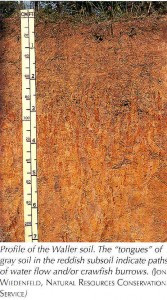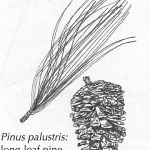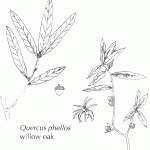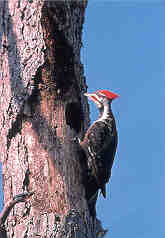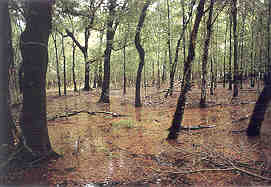
Coastal flatwoods wetland at the Armand Bayou Nature Center inundated in mid-late spring. The dominant tree is willow oak. (ANDREW SIPOCZ, TEXAS PARKS AND WILDLIFE)
Where are they?
Coastal flatwoods occur on poorly drained flats between rivers (interfluvial zones) on the coastal plain. The flatwoods wetlands stretch from the Louisiana border west to about the Houston area, and they are extensive.
Geology and Soils
Most of the wet flatwood areas are on low Pleistocene terraces of the major rivers and streams of the Upper Texas Gulf Coast. The geological formations are the Lissie, Beaumont, and Deweyville Formations.
Flatwood wetlands are underlain by mineral soils, and most have a claypan within 20 to 30 inches below the soil surface.
Soil Profile of a Coastal Flatwood Wetland
(Waller Soil Series, in a hardwood wet flatwood)
The surface soil to a depth of 8 inches is an acid brownish gray loam; to about 22 inches it is an acid light brownish gray loam, with many yellowish brown mottles. To a depth of 60 inches, the subsoil is an acid grayish brown clay loam with yellowish brown mottles, with many tongues and pockets of light brownish gray loam.
This soil remains saturated for most of the winter and early spring months.
(From the Liberty County Soil Survey)
Hydrology
Inundation in the coastal flatwoods is primarily from local precipitation, and is a result of the very slow runoff that characterizes these flats. The flatwoods are often confused with bottomland hardwoods, but flatwoods are not inundated with overbank flooding from local streams or rivers. The wet flatwoods are typically wet during the winter and early spring months. The soils will be saturated, and shallow standing water will be present in many places. Most of the wetness appears to be derived from precipitation, although groundwater may play a role in the eastern flatwoods near Beaumont.
Vegetation
Coastal flatwoods can be dominated by either pine or hardwoods.
Common trees of the drier pine wet flatwoods are longleaf, shortleaf, and loblolly pines. The wetter hardwood flatwoods include willow and laurel oaks, swamp chestnut oak, cherrybark oak, and sweetgum, with dwarf palmetto common in the understory.
The southern extension of the Piney Woods region of East Texas once was occupied by poorly drained longleaf pine woodlands that extended south into eastern Harris County. This community was a matrix of beakrushes, sedges, and grasses with scattered longleaf pines and was maintained by frequent burning. As fire was suppressed by humans, trees and shrubs like black tupelo, sweetgum, wax-myrtle, and yaupon increased. Loblolly pine is now dominant and has been favored by the commercial timber industry.
The hardwood flatwoods occur on the Coastal Prairies and Marshes region of the upper coast. The suppression of fire may have favored hardwoods in some areas that were longleaf pine savanna.
Animals
The endangered red-cockaded woodpecker favors the open longleaf pine woodlands described above. Other animals of wet flatwoods include bald eagles, other woodpeckers, warblers and many other songbirds, amphibians and reptiles, bats, rabbits, squirrels and other rodents, bobcats, foxes, raccoons, and deer.
Threats
Major threats are similar to those for riverine-forested wetlands. Since the mid-1950s, the area of commercial pine plantations (loblolly and nonnative slash pine) on the upper coast has increased by about 322,000 acres; an increase of about 390 percent! Some of this area was originally native pine or mixed pine-hardwood flatwoods.
Ecological Functions and Human Values
In addition to the timber and wildlife habitat values, flatwood wetlands perform most of the same water quality and flood control functions as riverine-forested wetlands.
